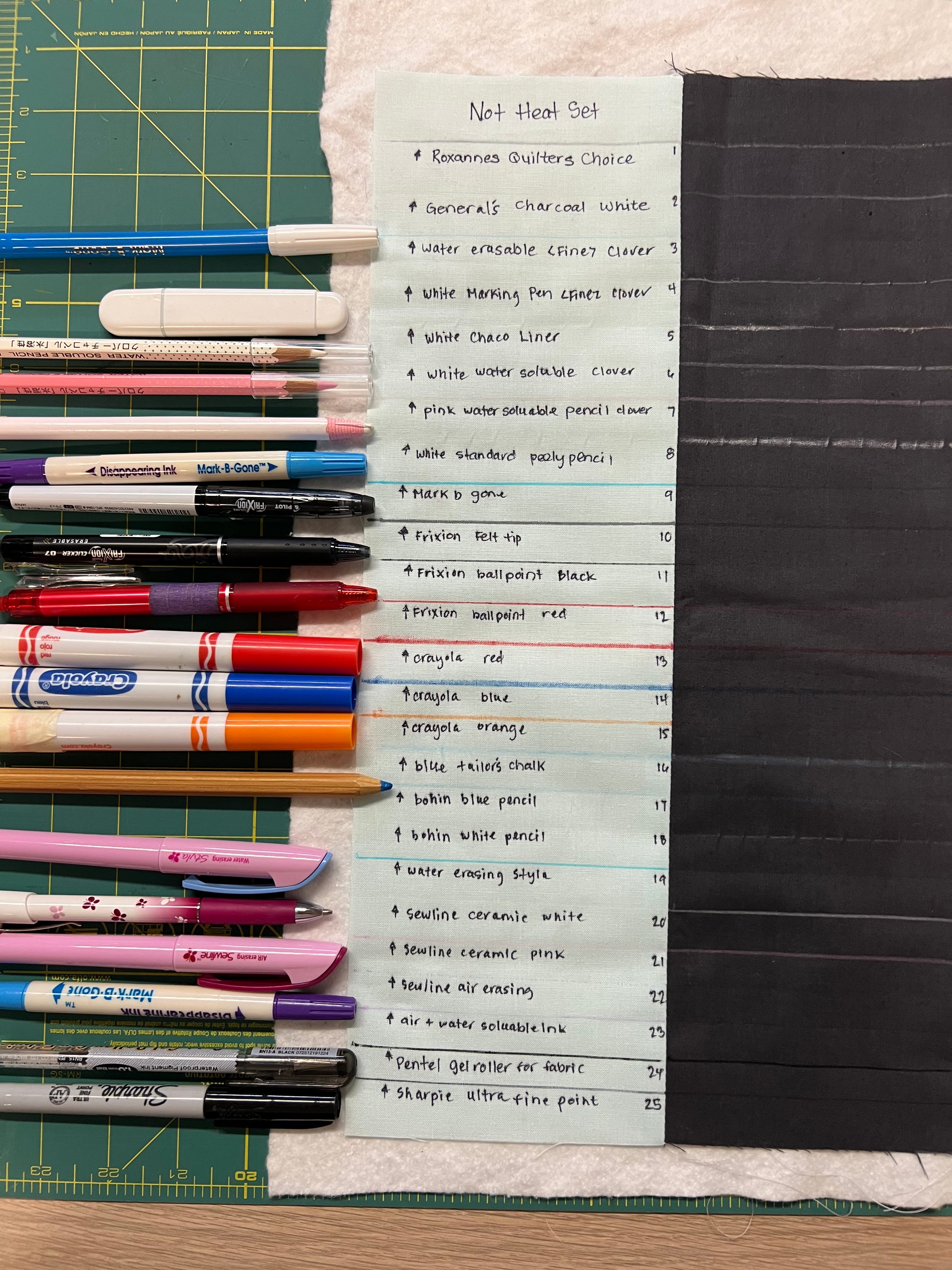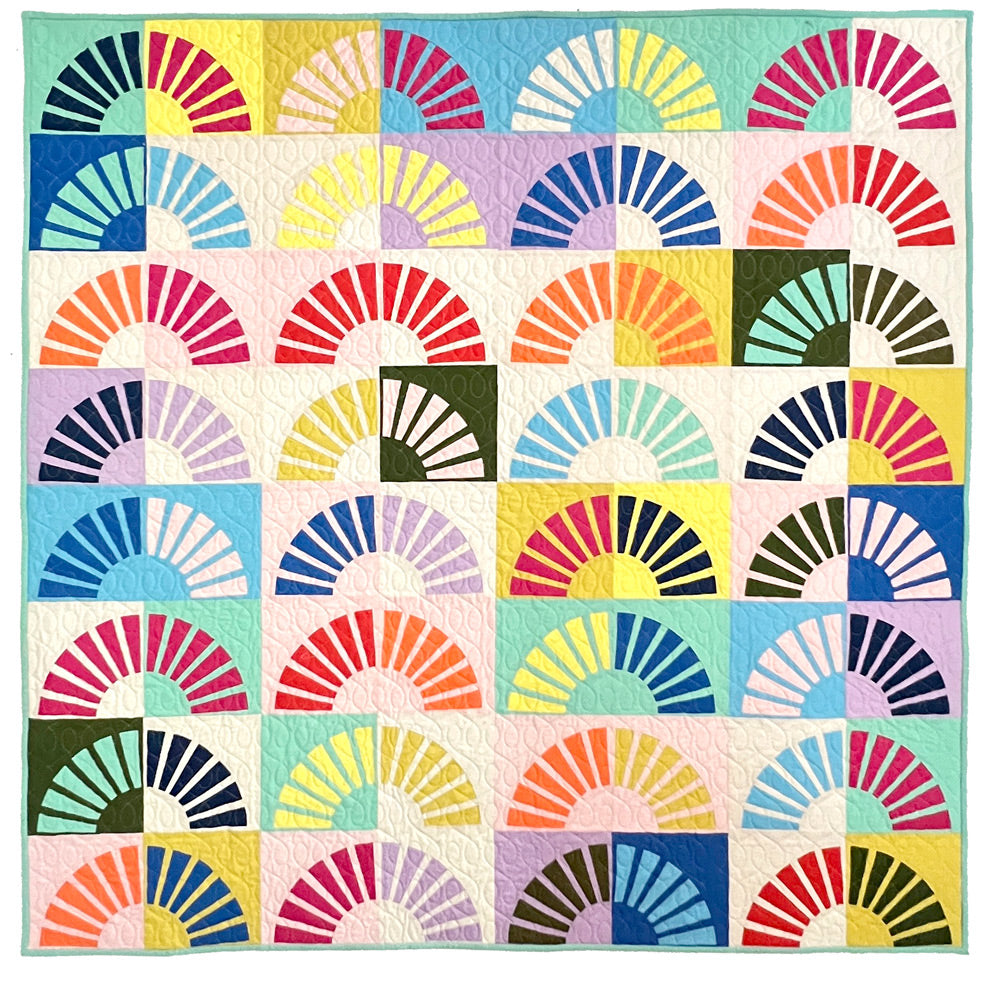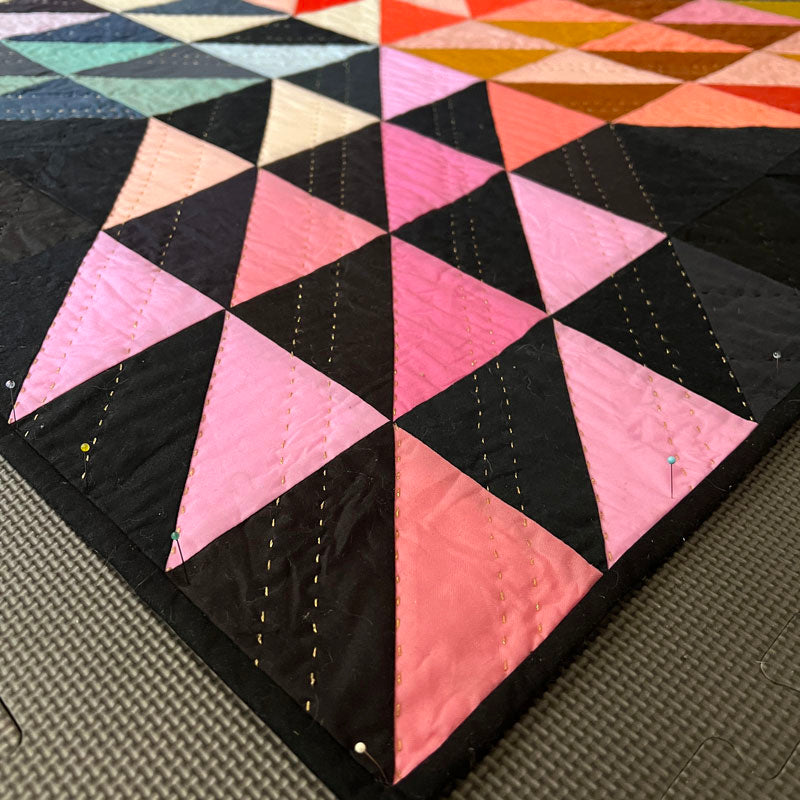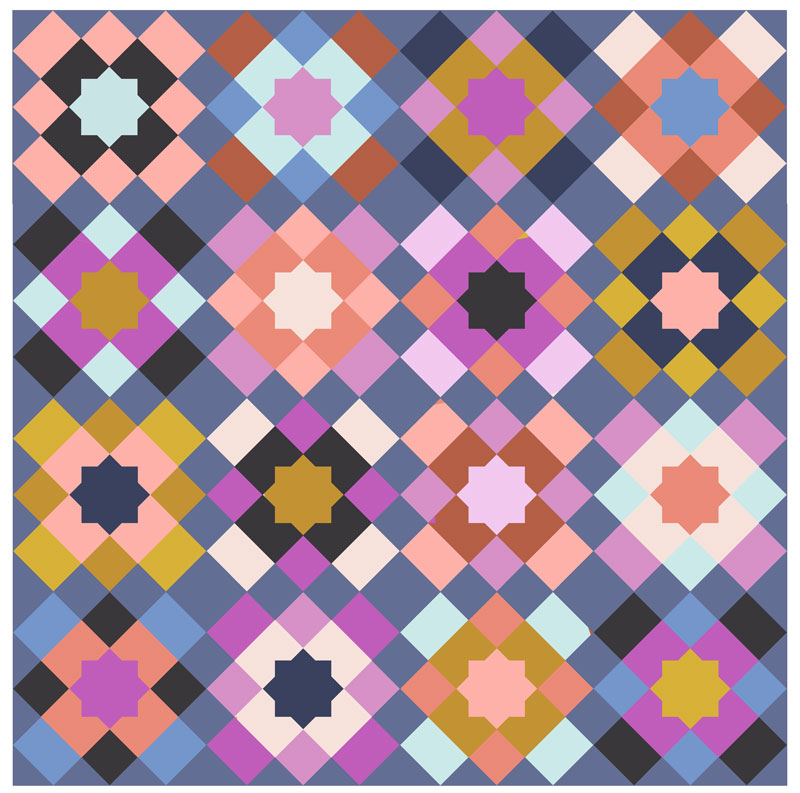Blog
Sunny: Design Inspiration
My newest quilt pattern and video course for my Sunny Quilt is available now and today I'm sharing some design inspiration to get you excited about this versatile quilt pattern.
Learn moreHow to Block a Quilt
If you knit, you will know all about blocking. It's the act of getting your finished project wet, then securing it to a flat surface to dry in an effort to make it dry flat.
Learn moreMarrakesh Quilt and Color
Hello quilters! I'm excited to share Marrakesh with all of you! This pattern gives you the freedom to experiment with color and how you want to break down the block, allowing each quilter to create a personalized look. So, let's talk a bit about elements that can really change how this block looks – color and value. Color Choices First off, let's talk about color. It's pretty straightforward; the colors you choose have a huge impact on your quilt's overall look and feel. For instance, cool colors like blues and greens can create a calm and soothing atmosphere, while warm colors like reds and oranges can give your quilt a cozy and inviting vibe. Additionally, where you put the colors in the quilt blocks creates a wonderful variety of looks! A Bit About Value & Contrast Light fabrics bring brightness, while dark ones add depth. Combining light and dark fabrics can create that eye-catching contrast that makes your quilt design stand out, or fade into a soothing calmness. When you play with contrast by pairing light and dark fabrics, you can really make your quilt design pop. High contrast creates bold, striking visuals, while low contrast offers a softer, more delicate touch. Pictures are the best way to showcase some examples of these design elements. I hope the mockups below will get your design mind buzzing and inspire you to play with this block! Have fun sewing! Tara You can purchase the pattern HERE!
Learn moreMarrakesh Block Variations
I'm excited to share Marrakesh with all of you! This pattern gives you the freedom to experiment with color and how you want to break down the block, allowing each quilter to create a personalized look.
Learn moreTraverse Quilt Pattern Now Available
Learn about different color possibilities for your next Traverse quilt!
Learn moreBig Ocean Sew Along Week 7 - Final Week!: Quilting and Finishing Our Big Ocean Quilt
Welcome to Week 7 of the Big Ocean Sew Along, our final week! Now that we have a quilt top put together, we need to decide how to finish it. This week I’ll share with you my process for deciding how to quilt each of the Big Ocean quilts I’ve made, and give you some tips for quilting yours. Be sure to join us tonight at 4pm on Zoom at the Big Ocean Sew Along Wrap Up Party! We’ll show off our quilt tops and other progress, and troubleshoot quilting plans if anyone needs help! There are so many options for quilting your Big Ocean quilt. I love how hand quilting looks, so I will probably be hand quilting my niece’s Big Ocean baby quilt. Truth though, I've run out of time and haven't basted the quilt, but I have a deadline of mid November so I can give it to her for her birthday!! My favorite threads are Wonderfil, and I carry them over in my shop. I usually use a 12wt thread to give my quilts a pop of color and texture. One thing I like about Wonderfil thread is that it has visual impact, but it is still light enough to pull through the quilt easily. Hand quilting can be used in so many ways. You can quilt your entire quilt by hand, or add just a few lines of hand quilting with mostly machine quilting to add some areas of interest to the overall design. Be sure to check out my Hand Quilting on-demand workshop if you’re new to hand quilting, or if you’re an experienced hand quilter and looking for a few tips and tricks to add to your practice. When deciding on my quilting plan for my Big Ocean quilts, whether I was hand quilting or machine quilting it, I made sure to accentuate that X shape that was so prevalent in the design. The quilting design you use can pull out shapes that are in the piecing and add so much to the finished design of your quilt. You might want to highlight the diamond shapes created by the HSTs or emphasize other lines and shapes that you love in this design. I can’t wait to see what you all decide on for your finished quilts. Be sure to share them on Instagram or Facebook, and tag #bigoceansal and #bigoceanquilt so I can see all your progress! Thank you so much for your enthusiasm for this pattern, and for sewing along with us these last seven weeks. I hope to see you tonight for our official sew along wrap up party! Check the sew along newsletter for the link. Here's the link to the hand quilting class if you want to check it out! https://tarafaughnan.com/collections/on-demand-classes/products/hand-quilting-on-demand-workshop
Learn moreBig Ocean Sew Along Week 6: Block and Top Construction
It’s hard to believe it is already week 6 of the Big Ocean Sew Along! We have done all of the design work. All that’s left is to sew our blocks together, and finish our quilts! These last steps are about using whatever small tips and tricks you have for using precision and sewing accuracy to influence the final look of your Big Ocean quilt. Today, I’ll be sharing a few techniques I use for that. Now that your design is final, you are ready to start sewing our blocks together. At this point in the process, take a picture to use as reference while you sew your blocks. The pattern refers to a block as the lozenge shape with our foreground colors, and the background colors on each corner. Be sure to sew your quilt top together in blocks first to keep everything in your design right where you want it to be. As you take your blocks down to be sewn together, be sure to keep them in order. I have a specific order I like to take mine down in. You might like to start with the block in the top left and work right to left, or maybe you do all the blocks in a column and start on the next column. Whatever order that works for you is great, but I recommend sticking to it so you don’t get lost! Start with a block and pull it down to be sewn together. I like to take the whole block down and lay it out on my sewing table. As I sew my HSTs together, I press the rows to alternating sides so that I can nest my seams later. You can always press your seams open if that is your preference. Nesting works for me, but I know that pressing flat or to the side is a hotly debated topic in the quilting community! Haha. If you are pressing to the sides, be sure to keep track of the direction you press so that you can nest your seams from one block to the next across the rows in your quilt, and down each column. For accuracy, I like to pin my seams as I sew rows of HSTs together in each block, and as I sew the blocks together in the final quilt top construction. A tailors clapper, or workable substitute, will help you press everything as flat as possible, which gives you a bit more accuracy in your sewing. Every bit helps! I use a small cutting board as a tailor’s clapper. You can even use the cardboard back of a pad of paper. A clapper catches the heat as it comes off your recently pressed fabrics and holds the heat on your fabrics for a few seconds longer, making your fabrics even flatter. Once you have all your blocks sewn together, get them back up on the design wall for one final look. Check the photo you took at the beginning to be sure your blocks are all in the right place. Sew your blocks into rows or columns. Sew your rows or columns together. Congratulations! Your Big Ocean quilt top is done! If you think you might hand quilt your Big Ocean quilt, check out my on demand workshop, Hand Quilting, a comprehensive guide to hand quilting for left and right-handed quilters. Come back next week for our final week of the Big Ocean Sew Along and join us for the Zoom wrap up party. See you then!
Learn moreBig Ocean Sew Along - Week 5: Designing and Sewing The Background
Welcome to Big Ocean Week 5! We are more than halfway through making our quilt and the end is in sight. Be sure to join us at our Zoom progress party tonight! You can share your Big Ocean quilt progress, and ask the group if you have any questions about colors, HSTs, or any other Big Ocean quilt questions. Check your emails for the link. It feels like I’ve been making HSTs for days and days, but with the foreground designed, all we have left to do is design and sew the background HSTs, then sew our blocks together next week! I don’t want to get ahead of myself, though. Let’s get working on our background! Now that we have our foreground mostly laid out - maybe we used a few single triangles filling out our lozenge shape so we could get an idea of what how we want our foreground to come together. Sometimes I have a pretty good idea of what I want my background color to be by this point in the process, but sometimes I need to audition colors. To do that, I take yardage or a large scrap of a few colors and place them in those empty background spots. For one of my Big Ocean quilts, I auditioned ochre, pink, and dark blue. For that quilt, I went with dark blue. For my nieces quilt, I started with purple in mind for the background and as it has come together, purple is still my first choice for the background. Once you have your background color chosen, you can audition multiple shades to get an idea of how dynamic you want your background to be. You can add some movement with a handful of colors, or keep it simple and use one color. Take a look at some options and decide what works best for your design. Once you’ve decided on your colors, you’ll start cutting triangles for HSTs. Be sure to lay out your background on the design wall before you sew your background HSTs. Because you’re designing in such a small spot, rather than the entire foreground, the placement of these triangles is really important for your overall design. You’ll want to match up background colors to those individual foreground triangles you laid out earlier and then fill in the rest of the background. Be sure to check out my on demand course, Value Creates The Design. I have some great tips in there about how value can add movement and contrast to your quilts. Be careful with bias edges! You’re working with individual triangles for the background, and that diagonal cut can stretch on you while you’re sewing. If you notice that you have some bowing in your triangles, be sure to adjust your presser foot tension to try to address that. Once you get your background HSTs cut, put them up on the design wall - or down on the design floor, whatever your sewing space allows! Take a step back and use the tips I shared earlier in the sew along to get a final look at your background and your finished design. Put some space between you and your design. Look at it from across the room, or take pictures of it. You’d be surprised how differently you see your quilts in a photo. Make adjustments to your design if you need to - move around some HSTs or change out some colors - and get ready to sew your blocks together next week! If you'd like to work ahead, or if you want more detailed guidance for every step of making your Big Ocean quilt, take a look at my Big Ocean Quilt on-demand workshop.
Learn moreBig Ocean Sew Along Week 4: Designing the Foreground
Welcome to Week 4 of the Big Ocean Sew Along! This week we’ll be designing our quilt. Over the last week, I have finished sewing most of my foreground HSTs. There were some colors that I removed for now since I never really reached for those colors. If you edit any colors out, set them aside in case you decide to add them back in later. Before you start designing, make piles of blocks with similar color combinations if you want to go with a "color theme" for each block. You might have blocks with variations of aqua and pink, or purple with purple, or various shades of orange with blue. There are so many possibilities depending on what fabrics you have chosen. Once you get these up on the design wall, you might change the design completely to be more random, or to reflect different color themes, but these piles are a good place to start. For my baby quilt for my niece, I'm going with a more random color placement, because this will only have 4 Big Ocean blocks total. Start putting blocks on the design wall and create your first foreground block, this lozenge shape. You might get a sense of what background color you want based on what you see once you start designing. You can move certain colors to that block edge to see if any color jumps out at you as a great background color. I have a feeling my background will be dark purple, but I don’t know yet. It’s all best guess as we go. This design step is a great time to use the cut triangles you have, if you have any. They allow for great flexibility, since you can put them into an empty spot, or put them over an existing triangle to find new color combinations that you might like. As you design your quilt, you’ll find what works for you. Maybe you want to do each lozenge with a theme, or maybe you prefer to do a more random layout. You can mix themes or do a two color quilt…. There are so many options. Stand back and take in what you have. Sometimes putting some distance between you and your quilt gives you a new perspective on your design. Take a picture of your quilt, and change it to black and white to see your value distribution. These steps help you get a different view of your quilt, which can make all the difference. Check out my on demand class, Value Creates The Design, for more on how to effectively use value in your Big Ocean foreground design. Designs change, and you don’t know where you’re going until you start going there. Be in the moment and let it evolve. Move your blocks around and build the spots where one color bleeds into the next to help your design take shape. Once you’re happy with your foreground design, get ready to design your background next week! Take a look at my Big Ocean on-demand class if you’d like to get lots more content for every step of the process of making your quilt.
Learn more










